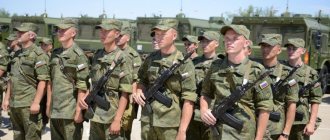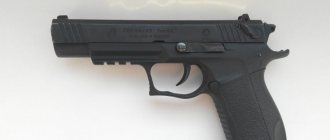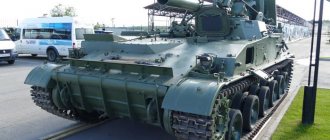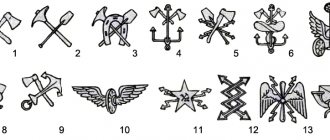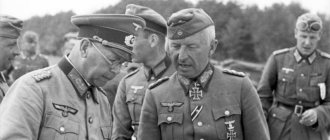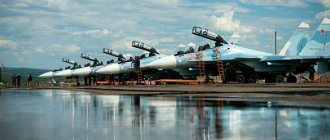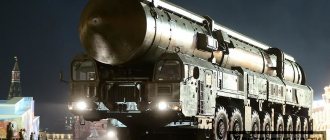When did the modern Russian army emerge?
After the collapse of the Soviet Union, the Russian army was formed on the basis of the Armed Forces of the former state in 1992. Before 1998, although army units participated in resolving the military conflict in Chechnya, there was no stable structure.
The reorganization made it possible to reduce the size of the regular army by half. And since 2001, conscripts’ service period becomes 12 months. Most of the military personnel are transferred to a contract basis. The structure of the army has changed since 2007, and recently regiments and divisions have returned again.
Tank troops of the Russian Federation
During the Soviet era, the main strike force of the Ground Forces was the Tank Forces. The Russian army received a huge fleet of combat vehicles from the USSR, numbering about 23,000 battle tanks as of 2005. Most of these tanks were obsolete models that were gradually withdrawn from service. In 2009, only 2,000 combat vehicles remained in service.
The most promising Russian tank is the tank on the Armata platform. By 2022, it is planned to purchase a significant number of such vehicles, thus updating the tank fleet. Now the most popular tank of the Russian Tank Forces is the T-72 and its various modifications. There are a significant number of tanks of the T-80 and T-90 models. In addition, according to unconfirmed reports, the Tank Forces have about 8,000 more tanks of older models that are in working order.
The big advantage of modern Tank forces are the following parameters:
- High mobility and maneuverability;
- Firepower;
- Resistance to weapons of mass destruction.
In addition, modern tanks are capable of crossing significant water obstacles and conducting combat operations with equal effectiveness both during the day and at night.
Division into territorial districts
As a result of military reform, military districts were formed on the territory of the Russian Federation:
- The Western District includes regions located near Moscow and St. Petersburg, where the headquarters of military units are located.
- Southern - covers the republics of the North Caucasus, Crimea. The commander-in-chief and headquarters are located in Rostov-on-Don.
- The largest part, 40% of the territory of Russia, belongs to the Central Military District. The units are led by a commander from headquarters in Yekaterinburg.
- The Eastern District covers part of Siberia and the Far East with 2 republics, 4 territories, 3 regions, Jewish Autonomy, Chukotka Autonomous District. The headquarters is located in Khabarovsk.
- The headquarters of the Northern Fleet, which is an independent military unit, is located in Severomorsk.
All districts are subordinate to the Commander-in-Chief of the Armed Forces - the President of the Russian Federation, V.V. Putin.
Military-industrial complex of the Ground Forces
Modern Russia inherited the military-industrial complex from the USSR. During the Cold War, it reached significant heights and even in that state was able to provide modern ground forces with everything they needed. But time does not stand still, and technology is developing rapidly. The Russian military-industrial complex, which practically did not develop in the 90s, began to rapidly gain momentum starting from the second half of the 200s. This has become especially noticeable in the last 10 years. Now Russia, which was previously the largest supplier of Soviet weapons, has begun to confidently lead in the field of sales of modern types of weapons. Most of the Russian weapons that are exported are intended for ground forces.
Currently, the Russian military-industrial complex fully provides the Ground Forces with everything they need:
- First of all, these are small arms of various types and ammunition for them;
- Armored vehicles of various types, including tanks, armored personnel carriers, infantry fighting vehicles and other similar vehicles;
- Artillery weapons of various types;
- Rocketry and much more.
Dozens of Russian design bureaus and various specialized industries are engaged in the development, production and testing of military equipment, weapons and uniforms. Although most of the ground forces' weapons are still models that were produced or developed in the USSR, military reforms that have been carried out in recent years are aimed at modernizing the Ground Forces in accordance with world standards.
In order to understand the full potential of the Ground Forces, it is necessary to take a closer look at each type of force that belongs to the Ground Forces.
Types of Armed Forces
The army includes 3 types of troops: ground forces, aerospace forces, and navy. Each consists of divisions with their own goals and objectives.
Ground troops
Conscripts most often end up in units related to the ground forces:
- motorized rifle;
- tank;
- rocket and artillery;
- Air defense.
Units are engaged in defense or offensive during an enemy attack on the territory of the country and act in a comprehensive manner. The ground forces also include engineering, railway troops and special forces units.
Motorized rifle units
This branch of the military is equipped with equipment, armored personnel carriers and infantry fighting vehicles, which helps infantry groups to move quickly. Together with tanks and artillery, young soldiers learn to hold occupied positions, carry out an offensive, breaking through enemy defenses. Encounter battles are organized by infantry units together with landing forces and army air forces.
Tank
The main striking force is tank formations. They are maneuverable and stable when nuclear strikes are carried out and weapons of mass destruction are used. During defense and attack, tanks support motorized rifle units and insure them.
Rocket and artillery
These types of troops were created to deliver a nuclear and missile strike to the enemy. Armed with howitzers, mortars, rocket and anti-tank artillery, they are capable of neutralizing enemy armed forces and suppressing them.
Air defense (air defense)
The troops are formed from reconnaissance, anti-aircraft missile, and radio engineering units. Their actions are aimed at identifying air attacks and neutralizing enemy actions. Military personnel are on combat duty in the territory, providing protection to their troops.
Reconnaissance formations detect enemy points, their location, and determine the number of enemy troops.
Engineering
Only specialists with engineering training are recruited into these formations. They will have to plan work to strengthen the territory, erect barriers, mine and clear the area, arrange crossings across water spaces, and perform camouflage.
Radiation, chemical, biological protection (RCBZ)
Everything related to detecting contamination of the area, camouflage, neutralizing contamination, and protecting combat units is carried out by these troops.
Connections
The purpose of these parts is to organize communication. It is necessary for leading troops during defensive and offensive actions. The work of signalmen is equipped with modern automated systems and command point facilities.
Signal troops are an important link in the functioning of the entire Russian Army
Aerospace Forces
The list of aviation branches consists of:
Daily routine of the military unit
- far;
- frontline;
- army;
- military transport.
There are formations of anti-aircraft missile and radio technical troops in the army, and special aviation units. Aviation is tasked with bombing enemy positions, transporting important cargo, weapons, and manpower. Space forces are called upon to identify threats from space and repel them. They launch vehicles, monitor satellites, and maintain their combat capability.
Navy
The tasks of submarine and surface forces, coastal troops, and naval aviation include protecting the territory of the Russian Federation located on the high seas. In peacetime, the forces of the Navy are aimed at searching and rescuing shipwrecked people. There are 5 flotillas located along the borders of the Russian state. Conscripts serve there for 2 years.
Surface forces
Fleet ships transport manpower and weapons. They cover the submarine forces. Their tasks include mining and demining of water areas.
Underwater
Nuclear-powered strategic and multi-purpose submarines carry out operations on:
- destruction of enemy military points on land and water;
- liquidation of sea vessels for various purposes;
- intelligence;
- landing troops on enemy territory;
- mining
Military service on underwater vessels is associated with difficulties and requires special knowledge and physical training.
Naval aviation
The actions of this branch of the Armed Forces are aimed at convoying ships, protecting them from attack from air and sea. Reconnaissance units help find the right direction for fleet ships.
Coastal parts
This type of military service consists of protecting naval bases. Military personnel need to cover their formations from the shore and parachute onto enemy territory.
Airborne Troops (VDV)
The best of the conscripts end up serving in the airborne troops, which are distinguished by a high level of combat training. The Airborne Forces are considered the backbone of the army's mobile forces and report directly to the Supreme Commander-in-Chief.
Strategic Missile Forces
These units serve to deter nuclear aggression and defeat enemy forces. The troops are armed with complexes that meet modern requirements. The created Topol M type weapons strengthen the country's military power.
Rear troops
The rear units supply the army. After all, military personnel need clothing, medications, food, and technical equipment.
Ground troops
This branch of the Russian Armed Forces is focused on conducting battles to ensure the security and defense of the state on land.
Motorized Rifle Troops (MSV)
This structure was formed in 1992. This is the most numerous type, consisting of motorized rifle units and subunits. MSVs are equipped with powerful weapons and effective command and control and reconnaissance equipment. They are designed to conduct combat independently or in combination with other types of aircraft.
Main goals:
- breaking through enemy defenses;
- defeat of the enemy;
- conquest of objects;
- pursuit of the enemy in case of retreat;
- holding positions;
- repelling enemy attacks;
- conducting oncoming battles.
Motorized infantry is characterized by high mobility and maneuverability.
Tank troops (TV)
The Russian Federation inherited strong tank forces from the Soviet Union. True, by 2009 the number of combat vehicles decreased from 23 to 2 thousand units.
TV is the main striking force of the army on land. They are equipped with all-terrain vehicles. Tanks of various types are fully armored. They are used in the main directions to deliver powerful and deep blows. Reliable protection, maneuverability and impressive firepower allow you to achieve your desired goals in a short time.
Tank forces
Missile Forces and Artillery (RF&A)
The missile defense forces were created in the early 60s as a result of the introduction of missile weapons. Such military units and formations serve as means of fire destruction and are capable of destroying enemy groups, air defense facilities, and hitting control posts and communication nodes.
The missile defense forces have missile systems and artillery systems. Constant attention is paid to the development of new ammunition widows.
Rocket Forces and Artillery
Air Defense Forces of the Ground Forces (Air Defense Forces)
Air defense troops repulse an enemy attack from the air. They carry out tasks to cover soldiers and rear facilities. This type of defense is organized in all types of combat. It includes reconnaissance and military air operations.
The Air Defense Army is equipped with equipment that has no foreign analogues. Its improvement is carried out by increasing maneuverability, endurance, high automation, and reducing the size of missile systems.
Air Defense Forces of the Ground Forces
Special troops
Special troops are military institutions that are designed to solve certain problems and support combat activities on land.
Corps of Engineers
Engineering troops are needed to accompany the military during an offensive, provide engineering reconnaissance and provide equipment to the battle area. They include various institutions and enterprises:
- military units;
- road engineering;
- pontoon connections;
- engineering and sapper.
In peacetime, special units of the engineering troops carry out measures to remove people from dangerous areas and eliminate the consequences of man-made and natural emergencies. To carry out combat missions, they use modern equipment, unique protective clothing of the latest generation, capable of protecting against mine explosions.
Corps of Engineers
RCB Defense Troops (RCBZ)
Chemical troops are capable of quickly carrying out tasks in extreme situations. They are designed to eliminate dangerous threats of a chemical and biological nature and the consequences of large-scale environmental disasters.
RKhBZ fighters mark the boundaries of areas of infection, conduct reconnaissance of the area and carry out procedures for disinfecting the territory. Chemical troops soldiers launch flamethrower mixtures for mass destruction of the enemy, organize activities for the transportation and release of waste radioactive substances.
Important! Thanks to the desperate feat of military chemists, it was possible to promptly eliminate the threat of a man-made disaster in connection with the accident at the Chernobyl nuclear power plant.
NBC protection troops
Signal Corps
A special branch of the military is engaged in the deployment of a communications system, the operation of automation equipment in control centers, and the provision of digital equipment. This includes:
- linear nodal parts;
- postal service;
- communications security service;
- communication technology divisions.
Signal equipment includes:
- equipment for voice-frequency telephony;
- photo and television equipment;
- message encryption devices;
- mobile stations.
Service requirements for conscripts
For conscripts, it is important where to go to serve and in which troops. You can ask in advance to be accepted into certain military units. But there are certain requirements for recruits. You need to know them:
- Those with good eyesight and physical fitness are hired as tank crews. But at the same time, the height of the conscript must be within 174 centimeters.
- To get into motorized rifle units, you need to belong to categories A1-B4.
- You can become a paratrooper if you have a strong psyche and excellent health.
- The aerospace forces need specialists with education and high intellectual qualities.
- Those who are taller than 180 centimeters, have excellent physical fitness, and have a stable psyche are recruited into the navy.
- A soldier in the engineering corps may not be in good health. Those with a low fitness category are selected.
- Special forces accept those who have already served in military service.
If young people want to go serve in certain troops, then they need to prepare themselves in advance. Assistance in training is provided by DOSAAF branches that train future recruits.
What are people in military service called?
Citizens in military service
, are military personnel.
Such citizens are assigned military ranks (see Article 6 of the Federal Law “On the Civil Service
of the Russian Federation” dated May 27, 2003).
military service
both on a voluntary basis and by conscription.
Interesting materials:
What are the basic requirements for correct posture that must be observed when working at a computer? What reports does an individual entrepreneur submit with hired employees? What kind of breaks are required when working with constant exposure from a PC? What indicators characterizing the performance of transport are the main ones? What are the rights and responsibilities of an employee? What rights do you need to work as a truck driver? What rights are indicated in the employee rights section of the job description? What are the advantages of working in the civil service? What are the benefits of working remotely? What reasons for a possible fall of workers should be identified during a workplace inspection?
Composition of troops in the military ID
You can determine where a reserve soldier served and for how long on his military ID. Persons acquire a military registration specialty when:
- serve on urgent conscription;
- graduate from a university faculty with a military department.
VUS numbers indicate where the recruit served. The numbers are arranged so that a specialist can use them to decipher suitability for service. You can find out in which units the citizen’s knowledge and skills were used. The letters indicate in which units they served. The letter A tells about the ground forces, the letter P for internal purposes, and the letter D for the landing forces.
There are cases when a specialty acquired in the army comes in handy in civilian life.
The structure of the army in Russia is such that recruits can choose the branch of the military for which they are suitable. Each branch of the Armed Forces has its own goals and objectives, which helps conscripts to be ready to defend their Fatherland in the future.
Strategic Missile Forces
The Strategic Missile Forces are considered an independent branch of the Russian Armed Forces. These troops were created to protect against a possible nuclear attack by the enemy, as well as to attack and completely destroy the military-economic potential of the enemy.
The Strategic Missile Forces consist of armies and missile divisions. Also under the control of the Strategic Missile Forces are military training complexes, institutions, training grounds and enterprises.
The basis of the Strategic Missile Forces' weapons are missile systems of both stationary and mobile types. Combat duty is considered the most active period and the highest combat readiness of the Strategic Missile Forces.
What about infantry?
Infantry is the main branch of the army in the ground forces and armed forces of states. ...Modern varieties
- Motorized rifle troops. The main means of delivering personnel is vehicles and armored vehicles. ...
- Marines. ...
- Air Infantry (Airborne Troops). ...
- Mountain Infantry (Mountain Rifle Troops).
Interesting materials:
Which cultural monument did Adashev take part in? Which region is Azerbaijan located in? In which class do they study the root of a number? In what class do millions pass? In which class are parallel lines? In what class do they teach Parus Lermontov? In which class do they teach winter mornings? In what climatic zone and in what climatic region is this region located on the Taimyr Peninsula? In which forest did Susanin lead the Poles? In which month are the days shorter?
Excerpt characterizing the Army (combined arms)
“You’ll never get well,” she said, forgetting her grief out of frustration, “if you don’t listen to the doctor and take your medicine at the wrong time!” After all, you can’t joke about it when you could get pneumonia,” said the countess, and in the pronunciation of this word, which was incomprehensible to more than one word, she already found great consolation. What would Sonya do if she did not have the joyful knowledge that she did not undress for three nights at first in order to be ready to carry out exactly all the doctor’s orders, and that she now does not sleep at night in order not to miss the clock , in which you should give low-harm pills from a golden box? Even Natasha herself, who, although she said that no medicine would cure her and that all this was nonsense, was happy to see that they made so many donations for her, that she had to take medicine at certain times, and even she was happy was that, by neglecting to follow the instructions, she could show that she did not believe in treatment and did not value her life. The doctor went every day, felt her pulse, looked at her tongue and, not paying attention to her murdered face, joked with her. But when he went into another room, the countess hurriedly followed him out, and he, assuming a serious look and shaking his head thoughtfully, said that, although there was danger, he hoped that this last medicine would work, and that he had to wait and see ; that the illness was more moral, but... The Countess, trying to hide this act from herself and from the doctor, slipped a gold piece into his hand and each time with a calmed heart returned to the patient. The signs of Natasha's illness were that she ate little, slept little, coughed and never perked up. The doctors said that the patient could not be left without medical care, and therefore they kept her in the stuffy air in the city. And in the summer of 1812 the Rostovs did not leave for the village. Despite the large number of swallowed pills, drops and powders from jars and boxes, from which Madame Schoss, a hunter for these things, collected a large collection, despite the absence of the usual village life, youth took its toll: Natasha’s grief began to be covered with a layer of impressions of the life she had lived, it It stopped being such an excruciating pain on her heart, it began to become a thing of the past, and Natasha began to physically recover. Natasha was calmer, but not more cheerful. She not only avoided all external conditions of joy: balls, skating, concerts, the theater; but she never laughed so hard that tears could not be heard from her laughter. She couldn't sing. As soon as she began to laugh or tried to sing to herself alone, tears choked her: tears of repentance, tears of memories of that irrevocable, pure time; tears of frustration that she had ruined her young life, which could have been so happy, for nothing. Laughter and singing especially seemed to her a blasphemy to her grief. She never thought about coquetry; she didn't even have to abstain. She said and felt that at that time all men were for her exactly the same as the jester Nastasya Ivanovna. The inner guard firmly forbade her any joy. And she didn’t have all the old interests of life from that girlish, carefree, hopeful way of life. Most often and most painfully, she remembered the autumn months, the hunt, her uncle and the Christmastide spent with Nicholas in Otradnoye. What would she give to bring back just one day from that time! But it was over forever. The premonition did not deceive her then that that state of freedom and openness to all joys would never return again. But I had to live. She was pleased to think that she was not better, as she had previously thought, but worse and much worse than everyone, everyone in the world. But this was not enough. She knew this and asked herself: “What next?” And then there was nothing. There was no joy in life, and life passed. Natasha, apparently, was only trying not to be a burden to anyone and not to disturb anyone, but she didn’t need anything for herself. She moved away from everyone at home, and only with her brother Petya did she feel at ease. She loved being with him more than with others; and sometimes, when she was face to face with him, she laughed. She almost never left the house and of those who came to them, she was only happy with Pierre. It was impossible to treat her more tenderly, more carefully and at the same time more seriously than Count Bezukhov treated her. Natasha Oss consciously felt this tenderness of treatment and therefore found great pleasure in his company. But she was not even grateful to him for his tenderness; nothing good on Pierre's part seemed like an effort to her. It seemed so natural to Pierre to be kind to everyone that there was no merit in his kindness. Sometimes Natasha noticed Pierre's embarrassment and awkwardness in her presence, especially when he wanted to do something pleasant for her or when he was afraid that something in the conversation would bring up difficult memories for Natasha. She noticed this and attributed it to his general kindness and shyness, which, according to her ideas, the same as with her, should have been with everyone. After those unexpected words that if he were free, he would be on his knees asking for her hand and love, spoken in a moment of such strong excitement for her, Pierre never said anything about his feelings for Natasha; and it was obvious to her that those words, which had so comforted her then, were spoken as all sorts of meaningless words are spoken to console a crying child. Not because Pierre was a married man, but because Natasha felt between herself and him to the highest degree that force of moral barriers - the absence of which she felt with Kyragin - it never occurred to her that she could get out of her relationship with Pierre not only love on her part, or, even less, on his part, but even that kind of tender, self-recognizing, poetic friendship between a man and a woman, of which she knew several examples. At the end of Peter's Lent, Agrafena Ivanovna Belova, the Rostovs' neighbor from Otradnensky, came to Moscow to bow to the Moscow saints. She invited Natasha to fast, and Natasha happily seized on this idea. Despite the doctor’s prohibition from going out early in the morning, Natasha insisted on fasting, and fasting not as they usually fasted in the Rostovs’ house, that is, to attend three services at home, but to fast as Agrafena Ivanovna fasted, that is, for the whole week without missing a single vespers, mass or matins. The Countess liked this zeal of Natasha; In her soul, after unsuccessful medical treatment, she hoped that prayer would help her with more medicine, and although with fear and hiding it from the doctor, she agreed to Natasha’s wishes and entrusted her to Belova. Agrafena Ivanovna came to wake Natasha at three o’clock in the morning and mostly found her no longer sleeping. Natasha was afraid to oversleep during matins. Hastily washing her face and humbly dressing in her worst dress and old mantilla, shuddering with freshness, Natasha went out into the deserted streets, transparently illuminated by the morning dawn. On the advice of Agrafena Ivanovna, Natasha fasted not in her parish, but in the church, in which, according to the devout Belova, there was a very strict and high-living priest. There were always few people in the church; Natasha and Belova took their usual place in front of the icon of the Mother of God, embedded in the back of the left choir, and a new feeling for Natasha before the great, incomprehensible, covered her when at this unusual hour of the morning, looking at the black face of the Mother of God, illuminated by candles , burning in front of him, and the morning light falling from the window, she listened to the sounds of the service, which she tried to follow, understanding them. When she understood them, her personal feeling with its nuances joined her prayer; when she did not understand, it was even sweeter for her to think that the desire to understand everything was pride, that it was impossible to understand everything, that one only had to believe and surrender to God, who at those moments—she felt—ruled her soul. She crossed herself, bowed, and when she did not understand, she only, horrified at her abomination, asked God to forgive her for everything, for everything, and to have mercy. The prayers to which she devoted herself most were prayers of repentance. Returning home in the early hours of the morning, when there were only masons going to work, janitors sweeping the street, and everyone in the houses was still sleeping, Natasha experienced a new feeling for her of the possibility of correcting herself from her vices and the possibility of a new, clean life and happiness. During the entire week during which she led this life, this feeling grew every day. And the happiness of joining or communicating, as Agrafena Ivanovna told her, joyfully playing with this word, seemed to her so great that it seemed to her that she would not live to see this blissful Sunday. But the happy day came, and when Natasha returned from communion on this memorable Sunday, in a white muslin dress, for the first time after many months she felt calm and not burdened by the life that lay ahead of her. The doctor who arrived that day examined Natasha and ordered her to continue the last powders that he prescribed two weeks ago. “We must continue, morning and evening,” he said, apparently conscientiously pleased with his success. - Just please be more careful. “Be calm, Countess,” the doctor said jokingly, deftly picking up the gold in the pulp of his hand, “soon he’ll start singing and frolicking again.” The last medicine is very, very good for her. She's very refreshed. The Countess looked at her nails and spat, returning to the living room with a cheerful face. At the beginning of July, more and more alarming rumors about the progress of the war were spreading in Moscow: they were talking about the sovereign’s appeal to the people, about the arrival of the sovereign himself from the army to Moscow. And since the manifesto and appeal were not received before July 11, exaggerated rumors circulated about them and about the situation in Russia. They said that the sovereign was leaving because the army was in danger, they said that Smolensk had been surrendered, that Napoleon had a million troops and that only a miracle could save Russia. On the 11th of July, Saturday, the manifesto was received, but not yet printed; and Pierre, who was visiting the Rostovs, promised to come for dinner the next day, Sunday, and bring a manifesto and an appeal, which he would get from Count Rastopchin. This Sunday, the Rostovs, as usual, went to mass at the Razumovskys’ home church. It was a hot July day. Already at ten o'clock, when the Rostovs got out of the carriage in front of the church, in the hot air, in the shouts of the peddlers, in the bright and light summer dresses of the crowd, in the dusty leaves of the trees of the boulevard, in the sounds of music and the white trousers of the battalion marching on the march, in the thunder of the pavement and in the bright shine of the hot sun there was that summer languor, contentment and dissatisfaction with the present, which is felt especially sharply on a clear hot day in the city. In the Razumovsky church there were all the Moscow nobility, all the acquaintances of the Rostovs (this year, as if expecting something, a lot of rich families, usually traveling to the villages, remained in the city). Walking behind the livery footman, who was parting the crowd next to her mother, Natasha heard the voice of a young man speaking about her in a too loud whisper: “This is Rostova, the same one...” “How thin she has become, but still good!” She heard, or it seemed to her, that the names of Kuragin and Bolkonsky were mentioned. However, it always seemed that way to her. It always seemed to her that everyone, looking at her, only thought about what happened to her. Suffering and fading in her soul, as always in a crowd, Natasha walked in her purple silk dress with black lace the way women can walk - the calmer and more majestic the more painful and ashamed she was in her soul. She knew and was not mistaken that she was good, but this did not please her now as before. On the contrary, this was what tormented her most recently, and especially on this bright, hot summer day in the city. “Another Sunday, another week,” she said to herself, remembering how she was here on that Sunday, “and still the same life without life, and all the same conditions in which it was so easy to live before. She’s good, she’s young, and I know that now I’m good, before I was bad, but now I’m good, I know,” she thought, “and so the best years pass in vain, for no one.” She stood next to her mother and exchanged words with nearby acquaintances. Natasha, out of habit, examined the ladies’ dresses, condemned the tenue [demeanor] and the indecent way of crossing herself with her hand in the small space of one lady standing nearby, again thought with annoyance that she was being judged, that she too was judging, and suddenly, hearing the sounds of the service, she was horrified by her abomination, horrified that her former purity had again been lost by her.
What to choose?
When wondering where it is better to go to serve after receiving a summons to the army, you need to decide what goals are being pursued. All existing Russian troops have prestigious units. Those who served there are revered and respected, but they will have to give all their strength to withstand not only the moral, but also the physical stress during the training of soldiers.
Moreover, it is not always easy to join the ranks of these troops. During the selection process, the presence of good physical data, absence of health problems, endurance and strong psyche are welcomed.
The big advantage of prestigious units is the opportunity to gain quite useful skills. Learn to control weapons, master martial arts and other skills.
However, based on observations, we can conclude that conscripts are distributed among various types of troops, without taking into account their personal wishes. Every serviceman who comes to the military registration and enlistment office for assignment will praise his unit, since any unit requires good soldiers.
If a potential recruit has any specialties or useful skills, there will be no problems with him in terms of education and training during military service. After the newly minted soldier is sent to one of the military units, after taking the oath, he will be re-assigned among the platoons of the unit. During this event, much attention is paid to the abilities of the young person.
Before receiving the notification, it is better to prepare in advance in order to increase the chances of getting into a good unit. Recommended:
- Get your physical shape in order. Conscripts who can withstand considerable physical exertion are in demand in any army;
- Train endurance, discipline, emotional stability;
- Have special education. A soldier who has a profession is valued above others.
Military service
The entire segment of the population, male and of military age, is required to register with the military commissariat and undergo a medical examination to determine their fitness category.
If he is unfit, then a military ID is issued and the man either ends up in the reserves of the Russian army or is completely released from service.
In category G, the young person receives a deferment for valid reasons (study, treatment) for a period of 6 months or 1 year.
In category A, B, the conscript is sent to military service.
Everyone knows that in the absence of health problems, a soldier may have a chance to serve in Russia's elite troops. The concept of elite troops is not enshrined at the legal level, but they include those units of troops that are in full combat readiness every minute and with the greatest combat capability.
And if there are minor illnesses, a soldier will only be able to get into a certain type of army, depending on the specific problem.
Compulsory service lasts 12 months, during which a soldier can sign a contract and serve in the Russian army with the opportunity to make a military career.
Is it possible to choose the direction of military service yourself?
According to generally accepted rules, during the conscription campaign, the young man will, of course, be asked about his wishes regarding the troops in which he would like to serve for military service, and based on his answer, a note will be made about his preferences. However, the distribution of newly minted soldiers does not particularly depend on their personal desires; they are mainly chosen by the so-called “buyers” who come to pick up the soldiers. Of course, there are times when a recruit's preferences are taken into account, due to compelling reasons or where the guy lives.
Another way to achieve being sent to serve in exactly the units you want is to present compelling arguments to the military commissariat. For example, if a young man wants to repay his debt to his homeland by serving as a military transport driver, it would be a good idea to take care of presenting a car license. It doesn’t matter whether the conscript manages to get into the military unit that he noticed or not, it’s still worth a try.
Literature
- Great Soviet Encyclopedia (GSB), Third Edition, published by the publishing house "Soviet Encyclopedia" in 1969-1978 in 30 volumes;
- Babylon - “Civil War in North America” / [under general. ed. N.V. Ogarkova]. - M.: Military publishing house of the Ministry of Defense of the USSR, 1979. - 654 p. - (Soviet Military Encyclopedia: [in 8 volumes]; 1976-1980, vol. 2).;
- Soviet Armed Forces - 60 years (Accompanying text, part two), N. I. Kobrin, B. P. Frolov, M., Publishing House "Znanie", 1978, 32 pp.;
- Soviet Armed Forces. History of construction. M., Military Publishing House (VI), 1978;
- Military encyclopedic dictionary. - M.: Voenizdat, 1984. - 863 p., with illustrations (ill.), 30 sheets (ill.);
- Combined arms army // [archive.is/NCQLc Great Patriotic War 1941-1945. Encyclopedia] / ed. M. M. Kozlova. - M.: Soviet Encyclopedia, 1985. - P. 501. - 500,000 copies.
- Dictionary of military terms / Comp. A. M. Plekhov, S. G. Shapkin - M.: Voenizdat, 1988;
- Edited by: V.A.
Zolotareva, V.V. Marushchenko, S.S. Avtyushina. In the name of Russia: Russian state, army and military education. - M.: "Rus-RKB", 1999. - P. 336 + incl.. - ISBN 5-86273-020-6. - Big Encyclopedic Dictionary - 2000.
